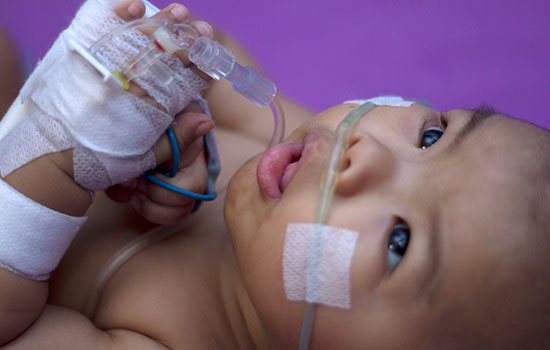


Joseph R. Anticaglia, MD
Medical Advisory Board
Imagine looking at your 6 month old child or grandchild frantically gasping for air, breathing rapidly with a whistling or rattling sound in the chest, and the baby’s ribs pulling in and out, and stomach moving up and down. You rush the infant to the emergency department (ED) of your hospital in critical condition. When you get there, you discover that the ED is crowded, doctors scurry about, and other children are experiencing similar problems.
In November of this year, there has been a surge in RSV or Respiratory Syncytial (sin-SISH-uhl) Virus infections. The virus caused emergency department doctors to be overwhelmed by this highly contagious disease. For example, in Oregon the influx of kids with RSV caused a shortage of pediatric hospital beds prompting Oregon Governor Kate Brown in the middle of November 2022 to declare RSV in children a public health emergency.

RSV is one the most frequent causes of breathing infections in children. The CDC labels RSV a “common respiratory virus that usually causes mild, cold-like symptoms. Most people recover in a week or two, but RSV can be serious, especially for infants six months of age or younger, and adults over the age of sixty-five.”
And “RSV is the most common cause of bronchiolitis (inflammation of the small airways in the lung) and pneumonia (infection of the lungs) in children younger than 1 year of age in the United States.”
This infection is most prevalent during the winter and spring months, and is not confined to children. Adults, and people with medical challenges, are susceptible to this disease which can attack the upper and lower respiratory tract (re to glossary).
RSV is worrisome for certain infants, young children, and the elderly. The CDC notes, “Each year in the United States, an estimated 58,000-80,000 children younger than 5 years old are hospitalized due to RSV infection. Those at greatest risk for severe illness from RSV include:
It is transmitted by being exposed to infected individuals (sneezing, coughing), or coming in contact with infectious material on inanimate objects such as toys, or doorknobs. If you touch something with the virus on it, you can get infected with this disease.
Once exposed to the virus it takes about five days before symptoms appear, and infected individuals remain contagious for approximately one week during the time they have the symptoms.
Symptoms include rapid breathing, struggling to inhale air into the lungs, wheezing, chest retractions on breathing in, and widening of the nostrils while breathing; other symptoms might consist of fever, cough, runny nose, poor appetite, and irritability.
Doctors obtain a complete medical history, perform a physical examination, and obtain relevant tests such as a blood sample, chest X-ray, culture and sensitivity of the child’s nasal drainage, and the use of a pulse oximeter to measure the amount of oxygen in the blood.
Most infection go away with supportive treatment in one to two weeks — think common cold. Use over-the-counter medications to manage pain and fever as needed. Do not give aspirin to children (Reye’s syndrome).
Encourage fluid intake to prevent dehydration. Decongestants in adults to manage nasal stuffiness.
A mild RSV infection can become a serious infection compromising a child’s, or adult’s airway due to bronchiolitis and pneumonia. Besides difficulty breathing, the individual might experience dehydration necessitating a hospital admission. In severe cases, patients may require IV fluids, supplemental oxygen, and medical intubation to keep the windpipe open so that air can get through to the lungs.
The recent surge in respiratory syncytial virus infections in certain parts of the U. S. have inundated hospitals and staff. Most cases of this disease are mild, and can be managed on an outpatient basis. But the infection is unpredictable outranking the flu as the leading cause of hospitalization in infants.
Infants under 6 months of age, adults over the age of 65, and individuals who struggle with chronic conditions, or weakened immune systems are at risk to develop severe RSV. There is no vaccine that prevents this disease, or antibiotic that cures this disease. People don’t develop long-lasting immunity to RSV after being infected with this virus. For good reasons, RSV remains on the radar as a potential serious threat to the health and wellbeing of infants and adults.
The respiratory tract is divided into the upper respiratory tract which includes the nose, the passage behind the nose down to the level of the larynx (voice box). The lower respiratory tract includes the area below the larynx, namely, trachea, lungs bronchi and alveoli.
Palvisumad monoclonal antibody is available for passive immunoprophylaxis to prevent severe RSV disease in high-risk infants.
This article is intended solely as a learning experience. Please consult your physician for diagnostic and treatment options.